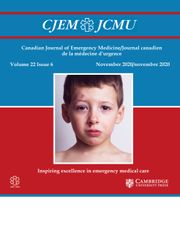No CrossRef data available.
Article contents
PL02: Derivation and validation of a feasible emergency department specific frailty index to predict adverse outcomes
Published online by Cambridge University Press: 15 May 2017
Abstract
Introduction: Frailty is an overarching concept in geriatric medicine. However its utility in the emergency department (ED) was not well understood. Objectives were to derive and validate an ED specific frailty index (FI-ED), using a cumulative deficits model; and to evaluate its ability to predict adverse outcomes. Methods: This was a large multinational prospective cohort study using data from: The Management of Older Persons in Emergency Departments (MOPED) and the interRAI study. The FI-ED was derived from the Canadian sample and validated in the multinational sample. Inclusion criteria were all patients ≥75 years old presenting to an ED. The FI-ED used 24 variables identified in the interRAI ED-Contact Assessment tool, a brief focussed geriatric assessment. Its ability to predict adverse outcomes were analysed by logistic regression with odds ratio (OR). Results: There were 3903 participants: 2153 in the derivation sample and 1750 in the validation sample. In the derivation sample, increasing FI-ED was significantly associated with admission (OR 1.43 [95% CI 1.34-1.52]), death in hospital (OR 1.55 [1.38-1.73]), prolonged hospital stay (OR 1.37 [1.22-1.54]), needs for Comprehensive Geriatric Assessment (OR 1.51 [1.41-1.60]) and discharge to long-term care (OR 1.30 [1.16-1.47]). In the validation sample, results were similar except for long-term care disposition (OR 0.84 [0.75 0.85]). Conclusion: The FI-ED conformed to characteristics previously reported in other geriatric populations. It was accurately derived and validated from a brief geriatric assessment feasible in the ED and can be used to predict adverse outcomes.
- Type
- Plenary Oral Presentations
- Information
- Copyright
- Copyright © Canadian Association of Emergency Physicians 2017


